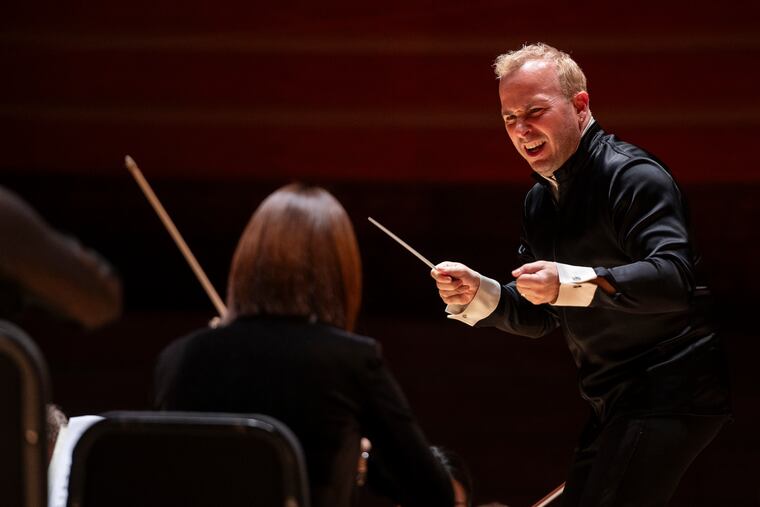Philadelphia should be seeing other orchestras. This ensemble from Berlin showed us why.
Filling in for Daniel Barenboim, Yannick Nézet-Séguin led the first concert in the new Kimmel series.

An all-Brahms orchestral program hardly seems like risky business, artistically or financially. Audiences and critics have long competed with each other over who loves the composer more.
But risk was very much in the air Sunday night for a tidy packaging of Brahms’ Symphony Nos. 3 and 4. The appearance of Staatskapelle Berlin at the Kimmel marked the resurrection of the arts center’s visiting orchestra series while highlighting just how brave it is to begin building a new audience during a pandemic recovery that, for the arts, has been tepid.
It’s true Verizon Hall wasn’t sold out. But for a launch, the audience was respectable — 1,376 seats were sold, or more than half the hall — and what the crowd lacked in size they made up for in verve. Largely young, they cheered long and loud, raising hopes that as one segment of the post-pandemic audience continues to stay home, another younger, equally engaged one, may be coming in behind them.
It was a knowing listenership, too. An imaginary applause meter would have proved just how absorbed they had been as Yannick Nézet-Séguin, conductor for the evening, asked individual players and instrumental sections to stand to accept ovations.
Staatskapelle Berlin may not have the name recognition of some of its peer ensembles — including another orchestra in its hometown some might have heard of — but their presence emphasized exactly the right point: There are great orchestras all over.
Cross-cultural experiences like this are absolutely critical in our age of political fracturing and social media siloing. Some of the differences between Staastkapelle Berlin and Verizon Hall’s resident orchestra were visually arresting: French horn players who floated their bells a few inches off their laps (as opposed to their American counterparts who keep them planted), and an ensemble of musicians who, at the end of the concert, all turned to each other for physical embraces and to thank one another.
Musically, it would be foolish to draw too many conclusions from a single concert of music by one composer. But on this night in this program, the Staatskapelle Berlin came across as a young, nimble ensemble with a pleasing, transparent sound.
What was the Nézet-Séguin factor? The originally announced conductor was Daniel Barenboim, who has just stepped down as the orchestra’s leader and who withdrew from this concert for health-related reasons. The performance with Nézet-Séguin was likely different than it would have been under Barenboim.
Perhaps even dramatically so. In Brahms’ Third, our Nézet-Séguin favored wildly flexible tempos and a dynamic range so wide that at its quietest you had to strain to hear certain diaphanous textures. The piece welcomes personal statements; Brahms holds in balance both the blithely carefree and some of his most intimate passions. Nézet-Séguin answered with an equally personal imprint. I’m not sure I ever want to hear again an orchestra taking the fast curves of the first movement with the same sense of daring. It was disconcerting, but intense.
Their interpretation of Brahms’ Fourth was less idiosyncratic and more cohesive. Admirable, how finely the ensemble had worked everything out: the way instrumentalists matched colors when passing the same note from one player to another, and how superior technique and critical thinking solved problems that have bedeviled others. Yun Zeng, principal hornist in the Fourth Symphony, got just the right snap to the rhythm of the second movement’s main theme, and principal oboist Cristina Gómez was a marvel all evening long. There’s a high, awkward entrance in that same second movement — a high “D” natural — that often comes across as tetchy. She made it sound like no work at all.
Brahms’ symphonies are foundational, which means they’re under the fingers of most musicians early in their careers. Even so, the Staatskapelle Berlin has developed interpretations happening on a higher plane. That the Kimmel has re-opened this important cultural bridge for the city is a privilege no one should take for granted again.
Remaining concerts in the Kimmel’s “Orchestras of the World” series: Orchestre Métropolitain with Nézet-Séguin, March 5 at 7:30 p.m., $25-$99; Bavarian Radio Symphony Orchestra led by Simon Rattle, May 1 at 8 p.m., $35-$139. Both concerts in Verizon Hall, Broad and Spruce Streets. Rush tickets may be offered, depending on availability, $15 online or $20 in person. kimmelculturalcampus.org, 215-893-1999.